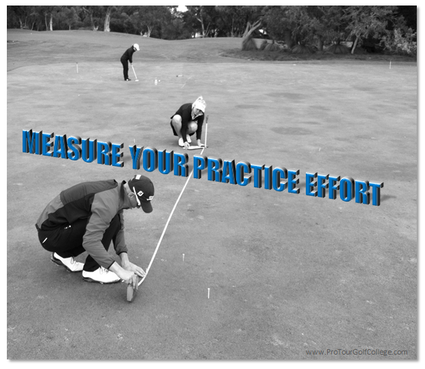 When you practice within the time units you have allocated, you will need to measure some important factors that will influence how effective your golf practice effort will be. A major key to effective golf practice time management is to know how long it takes you to hit a set of golf shots. At Pro Tour Golf College our students develop their golf skills around pre-planned sets of golf stroke repetitions, and these golf strokes could be either shots to a target/s, or sets of 10 practice drill strokes. Golf Practice Habit Number 4 – Managing Strokes and Shots We think of golf repetitions as either shots to a target, or strokes performed when doing drills, with or without the assistance of a training aid. So what is the best way to manage your stroke volume? Consider that stroke volume relates to mainly two important parts:
Do you know? This is an important question, and to answer it correctly you first of all need to determine how long it takes you to hit one set of 10 shots with a full pre-shot routine, to targets on the range, and also to make 10 practice drill strokes without a target. Completing a simple set time check for all the golf skills you practice using a stop watch or timer on your phone will help you to manage the time you need for the most important skills to practice. 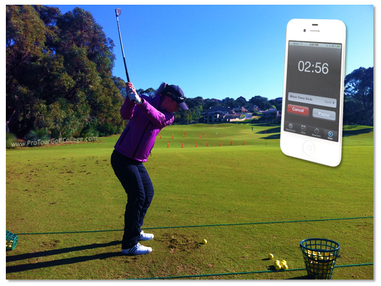 Time sets of 10 shots to find out how long it takes Time sets of 10 shots to find out how long it takes Once you know how long it takes to hit 10 shots with a pre-shot routine and also without, you can easily work out how many stroke repetitions you can perform inside a 15 or 30 minute time window. This is how you manage your stroke volume from day to day, and it represents the amount of strokes you perform per unit of time. You can notice that the actual stroke volume will vary depending on whether you are practicing a technical routine or a targeting routine. You should always design your weekly practice planner by determining how many of your practice time units are technical strokes and how many are targeting shots. How Long Will You Practice? The next part of managing stroke volume is working out how long you will practice? The rule of thumb is to practice for as long as you can maintain the highest level of focus possible. If you start to get distracted and you can’t recover from it, then it is advisable to go and do something else. Our suggestion is to build up a high level of tolerance for practicing for longer hours whilst maintaining a high level of focus (see golf practice habit 5 below). We’ve seen many elite level golfers spend 4, 5 or even 6 hours on the practice range where the duration is long but the quality is short. Yes it’s not uncommon to see elite golfers practice for a short while then check messages on their phone, or get involved in discussions with other golfers practicing thus padding out their practice time. Your goal should always be to extract the highest quality of stroke involvement from your investment of time on the golf range. 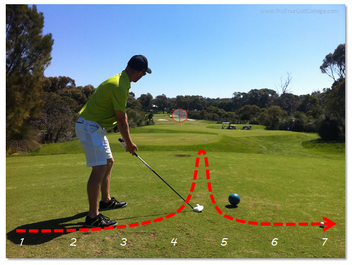 Golf Practice Habit Number 5 – Build Mental Focus Endurance Your goal should always be to execute sets of 10 strokes with a very high degree of focus on your stroke intention and stroke attention. This is critical, and your stroke intention in this instance relates to the goal or outcome for the shot you are playing or the drill stroke you are performing. The stroke attention part relates to how effectively you can focus on these outcomes to the exclusion of everything else. Each golf shot you hit must be hit with the intention of completing the procedure from walk in to the finish of the stroke to the very best of your ability. The Last Look A good idea is to peak your concentration on each shot by narrowing your focus to a distant target just before you hit your shot. We call this the last look and we teach our students to hit shots after the last look using a simple 1 to 7 scale where you peak your focus and get into the ideal performance state within the 4 to 5 range on the scale and then execute your shot.  Too often we see elite golfers just going through the motions and hitting shot after shot without their attention firmly focused on controlling their level of single-mindedness on each stroke. Here’s the thing you really need to understand; we all know that the objective is to execute each golf stroke to produce a desired outcome, but what is much more important than this (and overlooked), is the quality of your focus from stroke to stroke and shot to shot. This is the big deal in golf practice and nothing you do in practice is more important than this. You primary goal of practice should be to build up a very high level of mental endurance for focusing on executing each stroke without distraction—rather than achieving a perfect ball flight. Let's face it, many golfers can and do produce excellent ball flight outcomes when there’s no pressure on them, but as soon as the pressure barometer increases, many good golfers discover that their shot-making performance decreases. Why? It’s simple; they don’t practice a 'perfect focus strategy' as much as they practice a 'perfect golf stroke technique,' which is not nearly the same thing. Here's the bottom line; you need to isolate each golf ball out of a set and put all your focus into performing the stroke with no distraction whatsoever. Golf Practice Habit Number 6 – Measure Your Practice Effort Your daily practice generates results or outcomes, and being able to measure every bit of work you perform on the practice range is essential if you desire to improve your skills and lower your scores. The truth is that most elite golfers rarely if ever measure their practice effort, and as you can imagine this makes it very hard to determine where your game is, through any stage in your development cycle. There's an old saying that goes "what you can measure you can improve" and no truer words have ever been spoken. Practicing your golf skills without a way of measuring your results on a continual basis really means that you are guessing how much improvement you are making. Measuring your results is easy to do, and with a note book and pen/pencil you can start to track your progress on the practice range which will help you and your instructor to develop effective practice plans for generating ongoing improvement. What Can You Measure When You Practice? Here's a list of 5 simple things you can measure in your practice sessions:
With a daily practice planner like the one above you can measure how many shots you hit within your allotted time and you will know the answer to this question. You will be able to see whether you achieved your objectives for the practice session or not. Planning your practice and then performing it is an important part of every golf practice session because it will help you to effectively evaluate your practice effort so you can stay on top of your golf development. 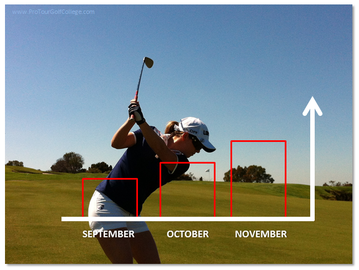 Golf Practice Habit Number 7 – Benchmark Your Golf Practice Skills Practice skill benchmarking is a great habit to develop and it's easy to do. Basically the idea is to compare your current golf practice performances for 1 month against results you wish to achieve in the same skills in 3 months time. For example you can compare your current 3 foot practice putting results (how many putts you make percentage) for all of September against a benchmark for the same skill in November. This monthly benchmark strategy gives you something to aim at over 3 months which will keep your focused on generating continuous improvement in the different skills that make up your game. You can benchmark virtually any golf skill you practice, against the results you want to achieve in the future--or even against the best golfers in the game if you want to. In the image below you can see we have established benchmarks for some of our 'A skills' that we identified in part 1 of our article. These are the weakest but most important golf skills for improving our score average in tournaments. You can see that for the 3, 6 and 10 foot putts we have established a benchmark of 1 percent improvement per month for the 3 months from September to November which may seem conservative to you. Understand that the idea behind this is to make steady progress, and since there are always variables like slope, speed, grain, etc. involved in the final analysis it is reasonable with short putts (within 12 feet) to strive for a small incremental improvement of around 1 percent per month. Typically in our Pro Tour Golf College program we look for student improvement in the short-game and long-game targeting skill practice with improvement of around 2 percent per month. We use a number of different improvement strategies and key performance indicators to drive performances upwards, and with the long game we establish specific target diameters at different distances. e.g. Driver tee shot carry - 210 - 220 yards = 24 yard target diameter In the driver example below we have established a target diameter of 24 yards wide for the tee-shot landing area and after 3 months if our golfer improves their tee-shot effectiveness based on the benchmarks established, we will narrow the target down to 22 yards for the next 3 months, and design a new set of benchmarks for him to aim. 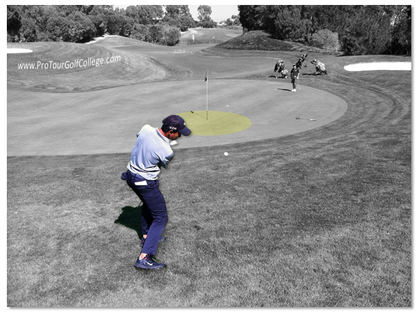 How many can you get into the target zone? How many can you get into the target zone? You can see that the long irons benchmark above (3 and 4 iron) is a target diameter of 18 yards wide. What this means is that our golfer has a target diameter of 18 yards to assess their accuracy with their 4 iron at 185 yards and their 3 iron at 195 yards. We have established this target diameter with a hit / miss tolerance of just 5 yards, which means that each golf shot they hit (in each set of 10 shots) must land within 5 yards of the distance to be counted. With our greenside skills practice we establish target zones for the different shots such as chip, pitch, flop and bunker shots. For ever set of 10 shots you hit to your target you measure and record how many are going into your target zone and like the other practice skills you benchmark your performance for a slight improvement each month to keep you on track for continuous improvement. e.g. Flop shot - 15 to 25 yards = 7 feet target zone (Diameter) Golf practice benchmarking challenges you to examine and also understand where your current golf skill standard is with the different shots that you practice from week to week, and month to month, and this gives you performance targets to continually aim and drive your game towards.  Thanks for Reading and The Best of Luck Well there you have it, 7 essential golf practice habits that when you apply them consistently and thoughtfully, you are guaranteed to drive your performances upwards, and your golf scores downwards. You must get into the habit of tracking, testing and measuring all your golf practice effort for every shot you play on the practice ground if you have any hope of becoming the player you wish to become. Look, the bottom line is that most golfers reading this article won't change the way they practice. However if you are someone who is looking for a competitive edge against the golfers you compete with in tournaments, then do yourself a big favor and implement this super simple process today. With a steady stream of results generated from your practice effort you can adjust, and implement specific strategies (with the help of your golf instructor) aimed at moving your performances ever closer to where you need them to be to become the golfer you truly wish to become. Lawrie Montague and David Milne - Pro Tour Golf College Your Success On Tour is Our Business Comments are closed.
|
Archives
June 2019
|
Proudly Supported By
Copyright © 2011 - 2018 Pro Tour Golf College
Website Managed By Golf Performance Media
All Rights Reserved
Website Managed By Golf Performance Media
All Rights Reserved

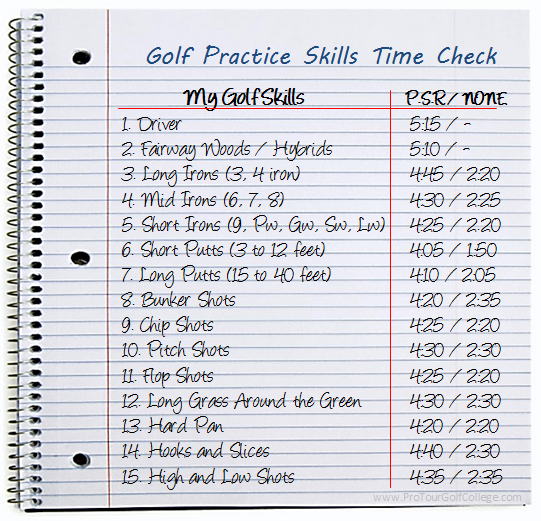
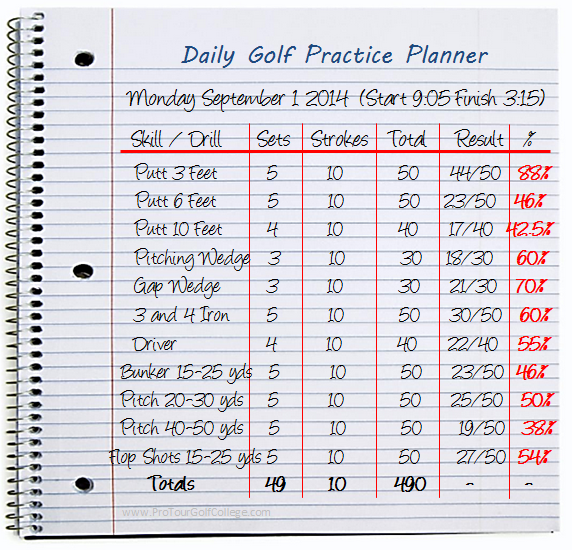
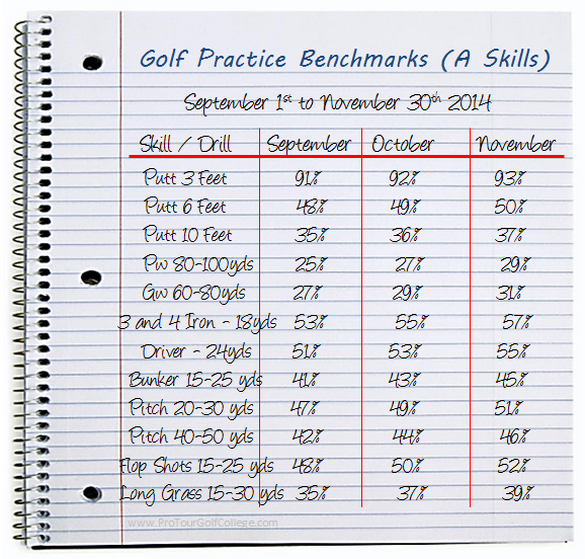
 RSS Feed
RSS Feed



